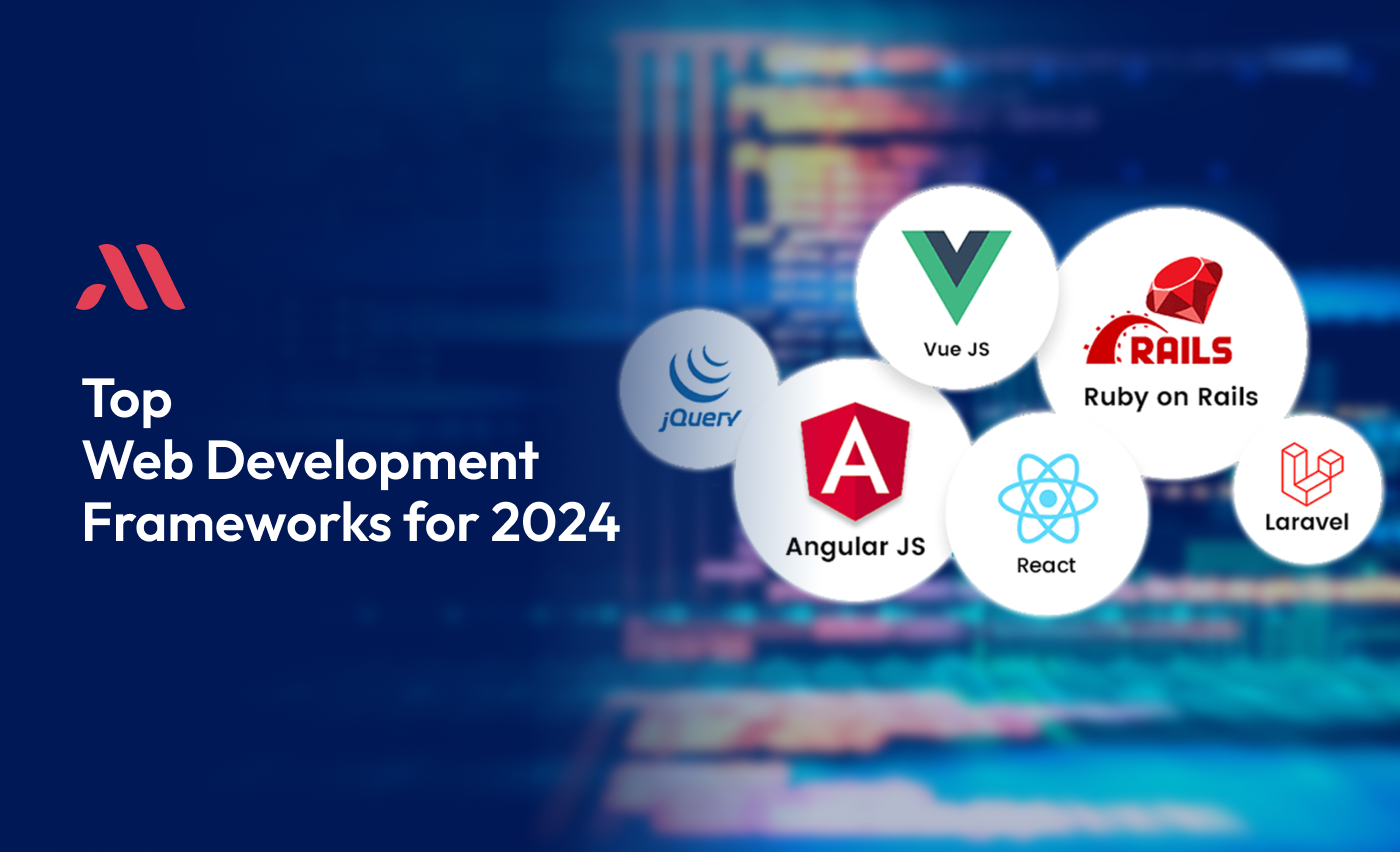When it comes to building websites, web development frameworks are most important. They help developers create amazing websites quickly and efficiently. For 2024, some frameworks at the top choices. Let’s explore the most popular web development frameworks that developers are excited about this year.
What Are Web Development Frameworks?
Web development frameworks are tools that provide a structure for building websites and web applications. They make the process easier and faster by providing pre-written code, libraries, and templates. Think of them as the building blocks for a website.
Why Use Web Development Frameworks?
Using a framework for website development has many benefits:
- Saves Time: Frameworks provide ready-made components, so developers don't have to start from scratch.
- Consistency: They help maintain a uniform structure across the website.
- Security: Frameworks usually include built-in security features.
- Support: Popular frameworks have large communities, meaning lots of resources and support.
Top Web Development Frameworks for 2024
Here are some of the most popular web development frameworks that are on the top in 2024:
1. React.js
React.js is a JavaScript library developed by Facebook. It’s one of the top web development frameworks because it makes creating amazing user interfaces easy. React helps developers to build reusable components, which speeds up the development process.
Why React.js?
- Fast and Efficient: React updates the user interface quickly when data changes.
- Component-Based: Build parts of your website like Lego blocks.
- Strong Community: Lots of tutorials and resources.
Detailed Features:
- Virtual DOM: React uses a virtual DOM to improve performance. When data changes, React updates only the part of the DOM that needs to be changed.
- JSX Syntax: JSX makes it easier to write and understand React components, combining HTML and JavaScript.
- Rich Ecosystem: With tools like Redux for state management and Next.js for server-side rendering, React’s ecosystem is huge.
Ideal Use Cases:
- Single-Page Applications (SPAs): React is perfect for SPAs due to its efficient re-rendering.
- Engaging UIs: Suitable for applications that require a dynamic user interface.
2. Angular
Angular, developed by Google, is a powerful framework for building dynamic web applications. It’s known for its robustness and is used for creating single-page applications (SPAs).
Why Angular?
- Comprehensive: provide everything you need for development in one place.
- Two-Way Data Binding: Automatically syncs data between model and view.
- Enterprise-Level: Great for large-scale applications.
Detailed Features:
- TypeScript: Angular uses TypeScript, a superset of JavaScript, which helps in catching errors early through its static typing.
- Dependency Injection: Angular’s built-in dependency injection helps manage how components depend on each other.
- RxJS: Angular uses RxJS to handle asynchronous operations, providing a powerful way to work with asynchronous data streams.
Ideal Use Cases:
- Enterprise Applications: Angular is robust enough for large-scale applications with complex business logic.
- Dynamic Web Apps: Perfect for applications that need a rich, dynamic experience.
3. Vue.js
Vue.js is another popular framework for website development. It’s easy to learn and integrate with other projects and libraries. Vue.js is popular for its simplicity and flexibility.
Why Vue.js?
- Simple to Learn: Easy to pick up for beginners.
- Versatile: Can be used for both small and large projects.
- Performance: Lightweight and fast.
Detailed Features:
- Reactive Data Binding: Vue’s reactivity system automatically updates the user interface when the data changes.
- Vue CLI: Vue CLI provides powerful tools for building and managing your Vue projects.
- Single-File Components: Vue helps you to write HTML, JavaScript, and CSS in a single file, making it easier to manage components.
Ideal Use Cases:
- Progressive Web Apps (PWAs): Vue is lightweight and efficient for PWAs.
- Small to Medium Projects: Ideal for projects that require quick development and flexibility.
4. Django
Django is a high-level Python framework that encourages rapid development and clean, proper design. It’s one of the most popular web development frameworks for building complex, database-driven websites.
Why Django?
- Security: Comes with built-in protection against common security threats.
- Scalable: Suitable for both small and large projects.
- Admin Interface: Includes a ready-to-use admin panel.
Detailed Features:
- ORM (Object-Relational Mapping): Django’s ORM helps you interact with your database using Python code as an alternative to SQL.
- Automatic Admin Interface: Django’s admin interface is autogenerated based on your models, making it easy to manage site content.
- Built-in Authentication: Django includes a robust authentication system right out of the box.
Ideal Use Cases:
- Content Management Systems (CMS): Perfect for building CMS due to its admin interface.
- Data-Driven Applications: Suitable for applications with complex database interactions.
5. Ruby on Rails
Ruby on Rails, usually just called Rails, is a server-side framework written in Ruby. It’s known for its convention over configuration approach, which speeds up development.
Why Ruby on Rails?
- Speed: Allows rapid development.
- Community: Strong community support.
- Built-In Testing: Helps ensure your code is reliable.
Detailed Features:
- Convention Over Configuration: Rails highlights convention over configuration, which speeds up development by reducing the number of decisions developers need to make.
- Active Record: Rails’ Active Record simplifies database interactions, helping developers write less code.
- Built-in Testing Framework: Rails comes with a complete testing framework, ensuring your application is reliable.
Ideal Use Cases:
- Rapid Prototyping: Rails is excellent for quickly developing prototypes and MVPs (Minimum Viable Products).
- E-commerce Sites: Many e-commerce platforms are built using Rails due to its speed and efficiency.
6. Laravel
Laravel is a PHP framework known for its stylish syntax. It’s designed to make the development process the best experience for the developer without sacrificing application functionality.
Why Laravel?
- MVC Architecture: Separates logic from presentation.
- Artisan Tool: Command-line tool that helps with repetitive tasks.
- Built-In Authentication: Easy to set up user authentication.
Detailed Features:
- Eloquent ORM: Laravel’s Eloquent ORM makes database interactions smooth and straightforward.
- Blade Templating Engine: Blade is a powerful templating engine that helps create dynamic views easily.
- Queues and Background Jobs: Laravel supports job queues and background processing out of the box, making it easy to handle time-consuming tasks.
Ideal Use Cases:
- Web Applications: Laravel is perfect for building modern web applications with a focus on simplicity and elegance.
- API Development: Laravel’s built-in support for API development makes it an excellent choice for creating RESTful APIs.
7. ASP.NET Core
ASP.NET Core is a cross-platform framework from Microsoft. It’s used to build modern, cloud-based, and internet-connected applications.
Why ASP.NET Core?
- Cross-Platform: Works on Windows, macOS, and Linux.
- Performance: High performance and scalability.
- Security: Complete security features.
Detailed Features:
- Razor Pages: ASP.NET Core uses Razor Pages, which makes building web UI easier and more productive.
- Cross-Platform: It’s designed to work on multiple platforms, including Windows, macOS, and Linux.
- High Performance: ASP.NET Core is known for its high performance and scalability, making it suitable for large-scale applications.
Ideal Use Cases:
- Enterprise Solutions: ASP.NET Core is best for enterprise-level applications that require high performance and reliability.
- Cloud-Based Applications: Its integration with Microsoft Azure makes it a strong candidate for cloud-based solutions.
How to Choose the Right Framework
Choosing the right web development framework depends on many factors:
- Project Requirements: Consider the specific needs of your project.
- Team Expertise: Choose a framework your team is comfortable with.
- Community and Support: Look for frameworks with strong communities.
- Scalability: Ensure the framework can handle future growth.
Final thoughts
In 2024, the landscape of web development frameworks continues to evolve. React.js, Angular, Vue.js, Django, Ruby on Rails, Laravel, and ASP.NET Core are some of the top web development frameworks that developers are excited about. Each of these frameworks has its strengths and is suited for different types of projects. By understanding your project needs and the strengths of each framework, you can choose the best framework for website development.
Remember, using the right web development framework can make your development process faster, more efficient, and more enjoyable. Happy coding!
Are you ready to achieve your digital dream? At MicraSol, we're experts in creating mobile and web apps that are customized to your particular requirements. Our team of experts is dedicated to providing creative solutions that boost the growth of your business and expansion.
Don't wait any longer to turn your ideas into reality. Contact MicraSol - App Development Company today and let's create something amazing together!
FAQS
1. What is a web development framework?
A web development framework is a set of tools and libraries that provide a structure for building websites and web applications. It includes pre-written code, templates, and components to help developers create web projects more efficiently and effectively.
2. Why should I use a web development framework?
Using a web development framework can save you time and effort by providing reusable code and components. It also ensures consistency in your project, enhances security with built-in features, and provides support through a strong community of developers.
3. What makes React.js popular for web development?
React.js is popular because it helps developers to create engaging user interfaces easily. It uses a virtual DOM for fast updates, has a component-based architecture, and is supported by a large community, making it a powerful and efficient framework.
4. How is Angular different from other frameworks?
Angular, developed by Google, uses TypeScript and provides a complete framework with everything needed for development in one place. It’s known for its two-way data binding and robustness, making it ideal for building dynamic web applications and single-page applications (SPAs).
5. What are the advantages of using Vue.js?
Vue.js is known for its simplicity and flexibility. It has a reactive data binding system, a powerful CLI, and supports single-file components. Vue.js is easy to learn and can be integrated with other projects and libraries, making it a versatile choice for web development.








